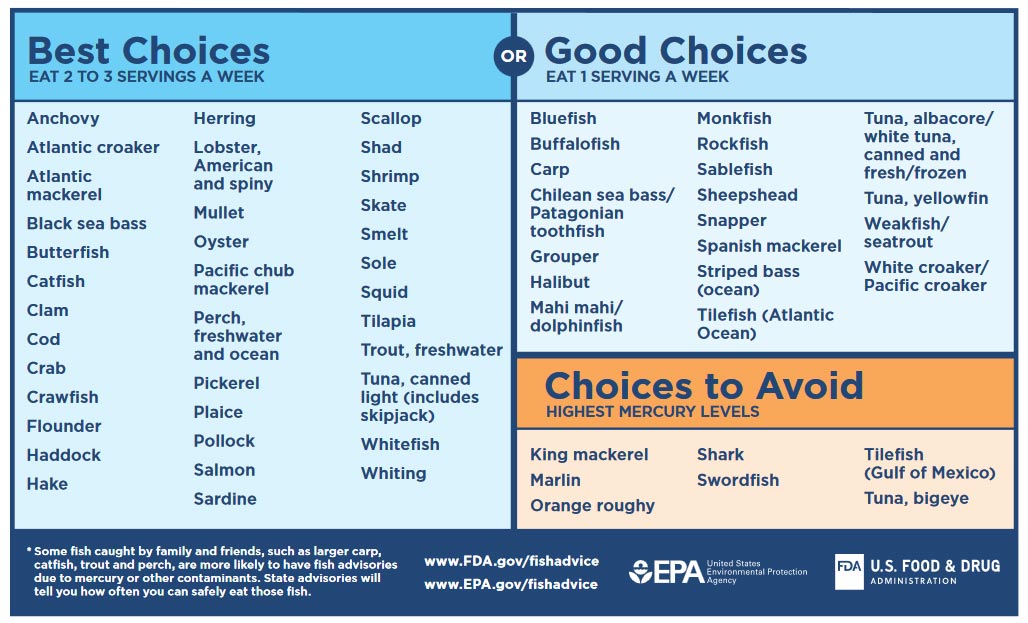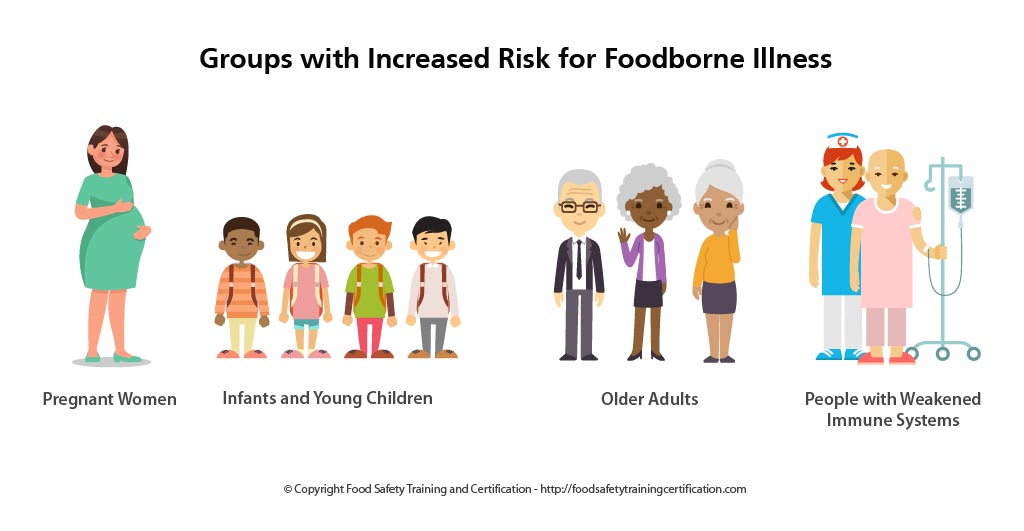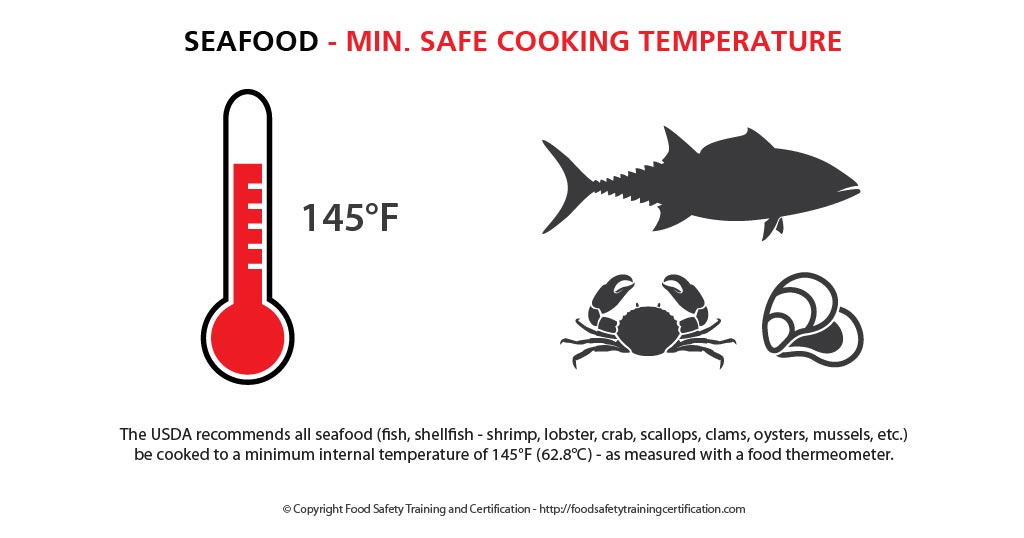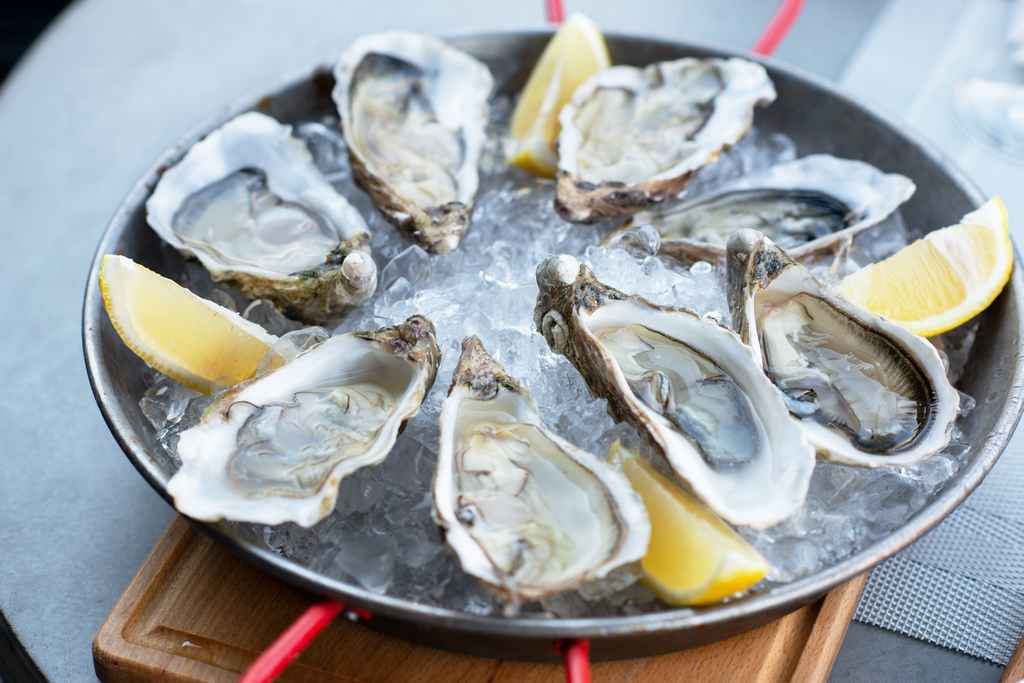Fish are important in a healthy diet with a lean, low-calorie source of protein. However, some fish may contain mercury or other harmful chemicals at sufficiently high levels to cause disease.
Federal, state and local governments issue fish consumption advisories when fish are unsafe to eat. The advisories may suggest that people avoid eating certain kinds or certain amounts of fish.
The FDA and EPA have revised their fish consumption guidance for pregnant and breastfeeding mothers and young children. The consumption revision is to help consumers who should limit their exposure to mercury – and choose from the many types of fish that are lower in mercury – including ones commonly found in grocery stores, such as salmon, shrimp, pollock, canned light tuna, tilapia, catfish, and cod.

Eating Fish: FDA July 2019 Guidance
The FDA and EPA have updated guidance regarding eating fish. This advice is geared toward helping women who are pregnant or may become pregnant – as well as breastfeeding mothers and parents of young children – make informed choices when it comes to fish that is healthy and safe to eat.
This advice supports the recommendations of the 2015-2020 Dietary Guidelines for Americans, developed for people 2 years and older. For advice about feeding children under 2 years of age, you can consult the American Academy of Pediatrics
Choose a variety of fish that are lower in mercury. You can use this guide and chart to help you choose which fish to eat, and how often to eat them, based on their mercury levels. The “Best Choice” have the lowest levels of mercury.
- You can eat 2 to 3 servings a week of fish in the “Best Choices” category,. For adults, a typical serving is 4 ounces of fish, measured before cooking, is a serving. Four ounces is about the size and thickness of an adult’s palm.
- You can eat 1 serving a week of fish in the “Good Choices” category, but no other fish that week.
- You should not eat fish in the “Choices to Avoid” category or feed them to young children. However, if you do, eat fish with lower mercury levels in the following weeks.
FDA Fish Consumption Advice Chart (PDF)

Fish and Shellfish Advisories and Safe Eating Guidelines
If you eat fish caught by family or friends, check for fish advisories. If there is no advisory, eat only one serving and no other fish that week.
A consumption advisory is a recommendation to limit or avoid eating certain species of fish or shellfish caught from specific water bodies or types of water bodies (e.g., lakes, rivers or coastal waters) due to contamination.
Advisories may be issued for the general public – or for specific groups of people at risk – such as:
- People who eat a lot of fish
- The elderly
- Pregnant women
- Nursing mothers
- Children
For current advisories visit each state, territory or tribe fish advisory website. Links can be found at the EPA Webste or through the EPA List of State, Territory and Tribe Fish Advisory Sites

Know Your Seafood – Make Informed Choices
Maintaining a safe seafood product requires caring for the product from the time it is caught until it is consumed; that responsibility doesn’t end at the point of sale. Local, state and federal food safety regulations require that fishermen – just like others in the seafood supply chain – be aware of and use proper handling and storage practices to ensure a safe product.
By simply asking a few questions about whether a store or restaurant offers sustainable seafood, you can help shape demand for fish that has been caught or farmed in environmentally responsible ways:
- Where is it from? (Domestic or imported – try to choose domestic).
- Is it farmed or wild? (Try to choose wild, unless it is sustainably farmed in the US).
- Is it caught or farmed locally? (Try to choose local foods over those shipped from far away).
- How is it caught? (Ask if the method has high bycatch or habitat damage).
- How is it farmed? (If you are buying farmed fish, when available, buy seafood raised in the U.S. in recirculating systems. Tilapia, shrimp, bass, trout and arctic char are examples of fish that are being farm-raised this way).
- Is it associated with any contaminants? (Mercury, PCBs, antibiotics, etc).
Learn what are the good choices you can make when it comes to seafood, and why you should make them.
This video from Monterrey Bay Aquarium’s Seafood Watch program highlights why such questions are important and how you can help protect the ocean just by asking your local grocery store or restaurant if they serve sustainable seafood.
Seafood Safe Cooking Temperature
Fish and shellfish are an important part of a healthful diet. In fact, a well-balanced diet that includes a variety of fish and shellfish can contribute to heart health and children’s growth and development. But, as with any type of food, it’s important to handle seafood safely in order to reduce the risk of foodborne illness.
Seafood Min Temperature: The safe internal minimum temperature for cooked fish is 145°F, or until the fish is opaque and flakes easily with a fork.

Eating Raw Fish & Shellfish – What You Need To Know
It’s always best to cook seafood thoroughly to minimize the risk of foodborne illness. However, if you choose to eat raw fish anyway, one rule of thumb is to eat fish that has been previously frozen.
- Some species of fish can contain parasites, and freezing will kill any parasites that may be present.
- However, be aware that freezing doesn’t kill all harmful microorganisms. That’s why the safest route is to cook your seafood.
An Important Note About Oysters:
Some oysters are treated for safety after they are harvested. That information may or may not be on the label. However, these oysters should still not be eaten raw by people at risk for foodborne illness. The post-harvest treatment eliminates some naturally occurring pathogens, but it does not remove all pathogens that can cause illness.

References and Sources
- FDA – Advice About Eating Fish
- EPA – Fish and Shellfish Advisories
- NOAA Fisheries – NOAA Fisheries is responsible for the stewardship of the nation’s ocean resources and their habitat.
- Monterrey Bay Aquarium – The Monterrey Bay Aquarium’s Seafood Watch program helps consumers and businesses make choices for a healthy ocean.
- Mercury in Seafood – What You Need to Know About Mercury in Fish and Shellfish (FDA) – Advice for pregnant women (and those thinking about pregnancy), nursing mothers, and young children.
- Risks of Eating Raw Oysters – Raw Oyster Myths (FDA) – Hot sauce does not kill harmful bacteria in raw oysters; neither does alcohol. Get the facts behind the myths.
- Raw Oysters Contaminated With Vibrio vulnificus Can Cause Illness and Death (FDA) – Explains the risks associated with eating raw oysters and how to prevent serious illness.
- General Information on Seafood – Fresh and Frozen Seafood: Selecting and Serving it Safely (FDA) – How to handle seafood safely in order to reduce the risk of foodborne illness.
- Cooperative Program Ensures Safe Shellfish (FDA)
How industry and government work together to keep shellfish safe.
See the slideshow or read the article
